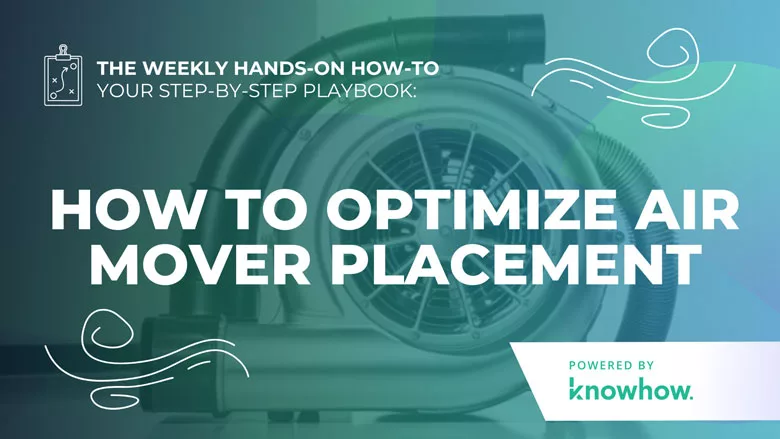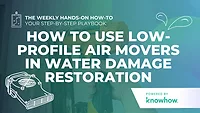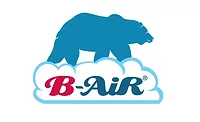Weekly Hands-on How-To powered by KnowHow
How to Optimize Air Mover Placement in Water Damage Restoration
Master air mover placement to speed up drying and improve your restoration process

Image provided by KnowHow.
When water damage hits, time is your enemy—and airflow is your best friend. Air movers are the muscle behind any effective water damage mitigation job, but using the right tools in the wrong spots? That just wastes time and energy.
This guide, powered by KnowHow, breaks down exactly how to get air mover placement right. From calculating the correct number of units to positioning them for maximum effect and tracking performance along the way, your crew will have everything they need to dry faster, smarter, and with total confidence. Let’s get into it.
1. Calculate the Correct Number of Air Movers
Before you start placing any equipment, you need to know how many air movers the job calls for. According to IICRC S500 guidelines, the number of air movers depends on the floor area, the configuration of the space, and the presence of any obstacles that interrupt airflow.
Here’s a general rule of thumb for residential settings:
- Use 1 air mover per 10 to 16 linear feet of affected wall space,
or - Use 1 air mover per 50–70 sq. ft. of affected floor area
(Whichever calculation results in more air movers)
Don’t forget to add additional units for:
- Closets and small rooms
- Stairwells or narrow corridors
- Large furniture or cabinetry blocking airflow
The goal is to ensure even coverage across all wet surfaces—no corners left untouched.
2. Position Air Movers for Maximum Effectiveness
Once you know how many air movers you need, the next step is to position them strategically to create an optimal drying environment. Proper placement isn’t just about pointing them at wet spots—it’s about building a drying system.
Follow these best practices:
- Create a circular airflow pattern (or vortex) throughout the space.
- Place units at a 45-degree angle to walls for even air distribution.
- Aim airflow across surfaces, not directly at one spot for extended periods.
Need to dry hard-to-reach areas? Use low-profile or specialty air movers to direct airflow under cabinets, into crawlspaces, or behind obstacles.
Reets Tip: Faster airspeed means more air pressure—which pushes drying power deeper into layered materials and wall cavities. Slow airflow won’t get the job done.
3. Always Run Air Movers on High Speed
This one’s simple but often misunderstood. Air movers should run on high speed throughout the drying process—period. Some techs mistakenly believe slowing down airflow near the end of drying is more “gentle,” but that’s just not true.
Slower airflow reduces energy transfer and prolongs drying time. Structures are made up of complex layers, not just surface materials. High airflow is critical to pushing through moisture that’s buried deep within assemblies.
4. Monitor and Adjust Placement as Needed
Drying isn’t a “set it and forget it” process. You’ll need to monitor progress regularly and make strategic adjustments as you go.
At a minimum:
- Take moisture readings every 24 hours
- Look for wet areas that aren’t drying as quickly
- Reposition air movers to target those zones more directly
Every change you make should have a reason—and that reason should be documented. Consistent evaluation ensures you’re using your equipment as effectively as possible.
5. Document Air Mover Use and Placement
If it’s not documented, it didn’t happen. That’s especially true when it comes to insurance claims, team coordination, and liability protection.
What to document:
- Number and type of air movers used (axial, centrifugal, low-profile)
- Placement locations (include a photo log or simple sketch)
- Speed settings (should always be “High” unless noted)
- Daily moisture readings and dry logs
- Reasoning for adjustments or repositioning
6. Key Reminders
Before you wrap up, remember these golden rules of air mover placement:
- Stick to the S500. It’s your playbook and your proof of performance.
- Don’t underestimate the power of airflow—more is often better.
- When unsure, check with a senior technician before making adjustments.
- Never unplug or move equipment without proper documentation and authorization.
When the Details Matter, KnowHow’s Got Your Back
When used correctly, air movers are more than just loud fans—they’re high-powered tools engineered to drive moisture out of even the trickiest materials. But air movers only work when you do. Proper setup, strategic placement, and consistent monitoring are what transform a chaotic job site into a controlled, efficient drying operation.
That’s where KnowHow makes all the difference. With thousands of expert-built templates, SOPs tailored to your company’s standards, and an AI expert in each of your crew members pockets, your team won’t just guess their way through air mover placement—they’ll nail it, every time.
Download our free Air Mover Placement template today, but if you need more than a template? Book a demo to see how KnowHow can level up your entire operation.
Looking for a reprint of this article?
From high-res PDFs to custom plaques, order your copy today!








